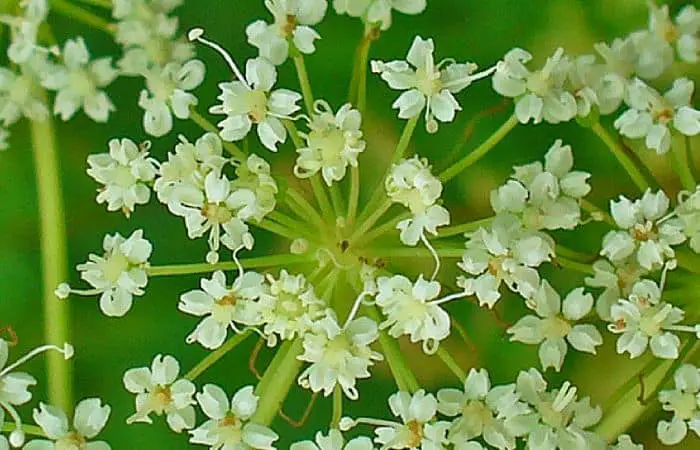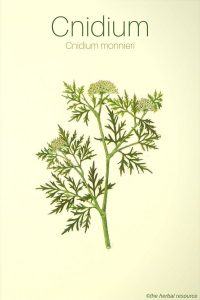Botanical Name: Cnidium monnieri.
Cnidium monnieri should not be confused with Bacopa monneri or Cnidium officinale.
Other Common Names: Monnier’s snowparsley, susangja (Korean), jashõshi (Japanese), she chuang zi (Chinese), kinesisk brændeskærm (Danish), monnierslirekjeks (Norwegian).
Habitat: The plant is native to China, Vietnam, Laos, Siberia and Eastern Europe. It prefers areas in full sun or half shade and requires evenly moist soil.
Description: Cnidium monnieri is a fragrant, annual plant that belongs to the parsley family (Apiaceae) and grows to 50–70 cm tall. The plant has an erect stalk with pinnate leaves.
The hermaphrodite flowers are white and bloom from May to July. The seeds (achenes) ripen from Jul to August. The plant is self-fertile and it is pollinated by insects.
Plant Parts Used: The seeds (achenes) are used medicinally. An essential oil is extracted from the seeds.
Traditionally, the young shoots have been eaten, but they can have a slightly toxic effect if consumed in large quantities.
Health Benefits and Medicinal Applications of Cnidium
Active Ingredients and Substances: The seeds contain 1.3% of essential oil with the following known substances: alpha-pinene, bornyl isovalerate, isoborneol, osthol (coumarin), cnidimine (edultin), isopimpellin, columbianadin, imperatorin, cnidilin, xanthotoxin (Methoxsalen) and archangelicin.
Osthol is regarded as the main active ingredient in the plant. Its true chemical name is 7-methoxy-8 {3-methylpent 2-enyl} coumarin.
Cnidium Uses in Chinese herbal medicine
In China, the plant is first mentioned in “The Divine Farmer’s Materia Medica” (Shen’nong Bencaojing) written between about 200 and 250 AD.
In Chinese herbal medicine the cnidium seeds have been commonly used in herbal mixtures that are formulated to “warm” the kidneys and strengthen yang energy.
The herb has a strong reputation as an aphrodisiac and it is frequently prescribed by Chinese medicine practitioners for male impotence.
In the past, the seeds were almost routinely used in herbal combinations that were specifically crafted for the Emperor.
An Aphrodisiac
Cnidium is used as an herbal remedy for erectile dysfunction (impotence) and to promote fertility in both men and women, often in combination with schisandra (Schisandra chinensis) and horny goat weed (Epimedium Sagittatum).
The main active substance in the herb is the coumarin compound osthol (osthole) which appears to have a similar effect to Viagra.
No studies have been done on the effectiveness of the herb in humans and the studies that exist have all been done using animal models, mostly on rodents (rats, rabbits).
These studies have validated some of the traditional uses of the herb and have shown that it does increase blood flow. They have shown that the osthol releases nitric oxide which is needed to relax the corpus cavernosa of the penis thereby allowing for increased blood supply to the genitals resulting in firmer and stronger erection.
Most of these studies have been somewhat inconclusive and bigger and more thorough studies are needed to fully confirm the medicinal effect of this medicinal plant.
Still, cnidium has been used traditionally for thousands of year as an aphrodisiac which might indicate that it does indeed possess the alleged therapeutic properties and therefore it could be helpful as a natural alternative to prescription drugs such as Cialis and Viagra.
External Uses of Cnidium
The cnidium seeds have antiseptic and disinfectant properties and are often used as an ingredient in lotions, powders or ointments for external uses as remedies for skin conditions such as eczema, ringworm and scabies.
The seeds are considered particularly valuable in diseases related to sexual organs, such as vaginal inflammation (vaginitis) and vaginal discharge.
The herb is effective against many strains of yeast (Candida), and it is often prescribed as a natural treatment for vaginal yeast infection.
Clinical studies in China indicate that the plant could be helpful as a treatment for vaginal inflammation caused by trichomoniasis a common sexually transmitted disease caused by the protozoan parasite Trichomonas vaginalis.
Dosage and Administration
A common dose of the herb in traditional Chinese medicine is 6-15g of the powdered seeds.
When using commercial products containing cnidium the manufacturer’s instruction should be followed.
No information on the medicinal dosages of the substance osthole in isolation is available but it is advisable to take it as an alcohol-based extract or with food.
Possible Side Effects and Interactions of Cnidium
Cnidium is generally considered a safe herb to uses but it is potent and should be utilized with care.
In large doses, it may cause nausea and vomiting.
Cnidium should not be used in conjunction with Viagra or Calais (Sildenafil).
Supporting References
Bensky, Dan & Andrew Gamble: Chinese Herbal Medicine. Materia Medica. Seattle, Washington, Eastland Press Inc. 1993.
Reid, Daniel: A Handbook of Chinese Healing Herbs. Boston, Shambhala 1995.
Teeguarden, Ron: The Ancient Wisdom of the Chinese Tonic Herbs. New York, Warner Books 1998.
Tierra, Michael: The Way of Chinese Herbs. New York, Pocket Books 1998.
Thordur Sturluson
Latest posts by Thordur Sturluson (see all)
- What is the Difference Between Hemp and Marijuana? - June 3, 2019


Leave a Reply